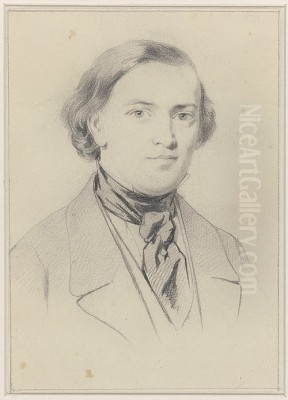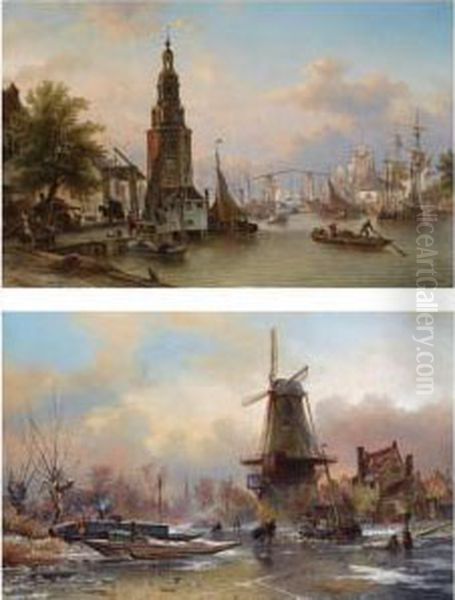
Elias Pieter van Bommel stands as a notable figure in nineteenth-century Dutch art, celebrated for his meticulous and atmospheric depictions of urban landscapes, particularly those of his native Amsterdam. Born in the bustling heart of the Netherlands in 1819, Van Bommel dedicated his artistic career to capturing the essence of Dutch cities, translating their architectural beauty and daily life onto canvas and paper with remarkable skill. His work provides a valuable visual record of the Netherlands during a period of significant social and economic transformation.
Van Bommel passed away in Vienna, Austria, in 1890, suggesting a relocation later in his life, perhaps seeking new inspirations or opportunities beyond the Dutch borders. Despite this move, his artistic identity remained firmly rooted in the Dutch tradition, drawing inspiration from the rich legacy of the Golden Age masters while portraying the contemporary world around him.
Artistic Foundations and Influences
While specific details of Elias Pieter van Bommel's formal training are not extensively documented in easily accessible records, it is highly probable that he received instruction within the established academic systems of his time in Amsterdam. The city was a major artistic hub, home to the Rijksakademie van beeldende kunsten (Royal Academy of Fine Arts), where many aspiring artists honed their craft. His work clearly demonstrates a mastery of perspective, draftsmanship, and the handling of paint, indicative of rigorous training.
His style resonates strongly with the traditions of seventeenth-century Dutch Golden Age painting. The meticulous attention to architectural detail recalls the work of masters like Jan van der Heyden and Gerrit Berckheyde, who specialized in cityscapes. Furthermore, Van Bommel's sensitivity to light and atmosphere, particularly in rendering the interplay of sun and shadow on buildings and water, echoes the achievements of artists like Johannes Vermeer and Pieter de Hooch, albeit applied to exterior scenes. He operated within a broader nineteenth-century European context that saw a resurgence of Realism, yet his specific approach remained deeply embedded in Dutch artistic conventions.
The Dutch Cityscape as Primary Subject

Van Bommel's oeuvre is dominated by views of Dutch cities. Amsterdam, his birthplace, features most prominently. He painted numerous iconic locations, capturing the unique character of its canals, bridges, churches, and bustling squares. His works often serve as topographical records, documenting the appearance of the city during his lifetime. He possessed a keen eye for the specific details that defined a location, rendering brickwork, reflections in water, and the distinctive gables of Dutch architecture with precision.
His interest was not limited to the capital. Surviving works and auction records indicate he also depicted scenes in other Dutch towns and cities, including Arnhem, Utrecht, Zaltbommel, and Kampen. Titles like "Market in Arnhem" and "Market Day at Zaltbommel" show his fascination with the vibrant public life unfolding within these urban settings. These market scenes allowed him to combine architectural painting with genre elements, populating his canvases with figures of merchants, shoppers, and onlookers, adding dynamism and narrative interest.
Paintings such as "View near the Koornmarktspoort in Kampen," now held in a Dutch private collection, demonstrate his commitment to exploring the diverse urban fabric of the Netherlands beyond Amsterdam. These works collectively offer a panorama of Dutch urban identity in the mid-to-late nineteenth century.
Signature Works and Artistic Representation
Several key works exemplify Elias Pieter van Bommel's artistic focus and skill. His "View of the Damrak and the Royal Palace of Amsterdam," dated 1881, is a significant piece. Measuring 47.5 x 100.5 cm, this painting captures a quintessential Amsterdam view, likely depicting the busy waterway of the Damrak with the imposing Royal Palace in the background. Its provenance includes the Van Zuylen van Nijevelt collection, and it was successfully sold at Bonhams in New York in November 2016, eventually finding its way into a Dutch private collection. This trajectory highlights the enduring appeal and market value of his major works.
Another important Amsterdam subject was the Westerkerk. A painting titled "Amsterdam, a View of the Westerkerk," measuring 94 x 73 cm, has appeared on the art market with estimates ranging from €8,000 to €12,000. Such works allowed Van Bommel to showcase his ability to render monumental architecture while capturing the specific atmospheric conditions of the city.
His market scenes are also highly regarded. "The Market at Arnheim" (or "Market in Arnhem"), a canvas of 51.5 x 67 cm, was noted for its cool color palette and the clarity with which the artist depicted the bustling activity – the trees, buildings, and numerous figures animating the space. Auction estimates for this work reached €16,000 to €18,000, indicating strong collector interest. An earlier work, "Market Day at Zaltbommel" from 1852, provides insight into his style during the earlier phase of his career.
Other documented works include "Utrecht, Mariaplaats met het Haus voor de Kunst en Wetenschap," auctioned by Galerie Paffrath in Düsseldorf, and more intimate scenes like "Unloading a boat at an inn," held in a private collection in Bergen. The title "Hollandsche Haven" (Dutch Harbor) suggests he also tackled maritime aspects of city life. These examples underscore his consistent engagement with Dutch topography and daily activities.
Style, Technique, and Realism
Elias Pieter van Bommel worked primarily in oil on canvas, though watercolor works are also known. His style is firmly rooted in Realism, characterized by a commitment to accurate observation and detailed representation. He avoided overt romanticization, preferring a more objective, though still aesthetically pleasing, depiction of the world around him. His draftsmanship was precise, allowing him to render complex architectural structures with confidence.
A key feature of his technique is the skillful handling of light and shadow (chiaroscuro). He adeptly captured the effects of sunlight on building facades, the reflections on water surfaces, and the overall atmosphere of a scene, whether it be a bright market day or a more subdued view. This sensitivity to light contributes significantly to the convincing realism and mood of his paintings.
His compositions are typically well-balanced, often employing established perspectival systems to create a sense of depth and spatial coherence. While architecture forms the backbone of his cityscapes, Van Bommel effectively integrated figures (staffage) into his scenes. These figures are not mere accessories; they animate the urban environment, illustrating its function and capturing the human element of city life, whether it's the bustle of a market or the quiet activity along a canal. His palette could vary, sometimes employing the "cool tones" noted in his Arnhem market scene, but often utilizing a naturalistic range of colors appropriate to the subject and lighting conditions.
Contemporaries and Artistic Milieu
Van Bommel practiced his art during a vibrant period in Dutch painting. He was a contemporary of several other artists who specialized in similar themes, creating a competitive yet stimulating environment. Perhaps the most direct comparison can be made with Cornelis Springer (1817-1891), another highly successful painter of meticulously detailed Dutch townscapes. Both artists often depicted similar locations, sometimes even from comparable viewpoints, inviting direct comparison of their styles and techniques.
Other notable contemporaries specializing in Dutch city or architectural views include Adrianus Eversen (1818-1897), Kaspar Karsen (1810-1896), and members of the Koekkoek family, particularly Willem Koekkoek (1839-1895), known for his winter cityscapes. Bartholomeus Johannes van Hove (1790-1880), who was active in The Hague and taught many younger artists, may have been an influence or even a teacher, given his own focus on cityscapes and church interiors.
While Van Bommel focused on exteriors, Johannes Bosboom (1817-1891) excelled in depicting church interiors with a profound sense of light and space. Artists like Wouter Verschuur (1812-1874), known for his paintings of horses, often placed his subjects within detailed urban or stable settings, overlapping thematically.
Although distinct from the later Hague School movement, which emphasized looser brushwork and atmospheric landscapes, Van Bommel's career overlapped with the emergence of key Hague School figures like Jacob Maris (1837-1899), Anton Mauve (1838-1888), and Hendrik Willem Mesdag (1831-1915). These artists also drew inspiration from Dutch life and landscape, albeit with a different stylistic approach.
Internationally, the Indonesian painter Raden Saleh Ben Jaggia (c. 1811-1880) was active during part of Van Bommel's lifetime, though his focus on dramatic, often Orientalist or nautical themes, contrasts sharply with Van Bommel's Dutch realism. There is no documented evidence of direct collaboration between Van Bommel and Raden Saleh, or indeed significant collaboration with most other named contemporaries, suggesting he pursued a relatively independent path focused on his chosen specialty. His work should be seen within this rich tapestry of nineteenth-century Dutch art, where traditional themes were revisited through a lens of contemporary realism.
Exhibitions, Collections, and Market Reception
Elias Pieter van Bommel's works appear to have enjoyed consistent appreciation throughout his career and continue to be sought after on the art market. His participation in exhibitions during his lifetime is likely, as this was the primary way for artists to gain recognition and patronage, although specific records of major awards are not highlighted in the provided sources.
His paintings feature regularly at prominent auction houses, including Bonhams (New York), Van Ham Kunstauktionen (Germany, though the snippet mentions an Amsterdam sale), and Galerie Paffrath (Düsseldorf). The auction prices achieved, such as the estimates exceeding €15,000 for his market scenes, attest to a strong and sustained collector interest. The provenance of works like the "View of the Damrak," once in the aristocratic Van Zuylen van Nijevelt collection, further indicates the high regard in which his paintings were held.
While his works are frequently found in private collections across the Netherlands and internationally (e.g., Bergen, Norway), their presence in major public museum collections seems less prominent compared to some of his contemporaries like Springer. Snippets mention potential links to Museum Boijmans Van Beuningen or the Frans Hals Museum, but these require careful verification; the reference to a 1930 work ("La Virgen del Perdón") at the Frans Hals Museum attributed to him is chronologically impossible and likely erroneous. The Museum van Bommel van Dam in Venlo, despite the name similarity, focuses on modern and contemporary art and is not directly associated with Elias Pieter van Bommel. His work is perhaps best accessed today through auction catalogues and specialized dealers focusing on nineteenth-century European art.
Legacy: Chronicler of an Era
Elias Pieter van Bommel's legacy lies in his dedicated and skillful portrayal of the Netherlands in the nineteenth century. As a painter of cityscapes, he captured both the enduring architectural heritage and the contemporary life of Dutch towns and cities. His realistic style, characterized by meticulous detail, accurate perspective, and a fine sensitivity to light and atmosphere, provides viewers with vivid and engaging glimpses into the past.
He stands as a significant representative of the Dutch Realist tradition in the nineteenth century, successfully adapting the precision and observational focus of the Golden Age masters to depict his own era. While perhaps not as revolutionary as some of his European contemporaries exploring Impressionism or other avant-garde movements, Van Bommel excelled within his chosen genre. His paintings remain valuable not only as aesthetically pleasing works of art but also as historical documents, preserving the appearance and ambiance of Dutch urban environments during a period of transition. His continued presence on the art market confirms the lasting appeal of his faithful and atmospheric urban portraits.